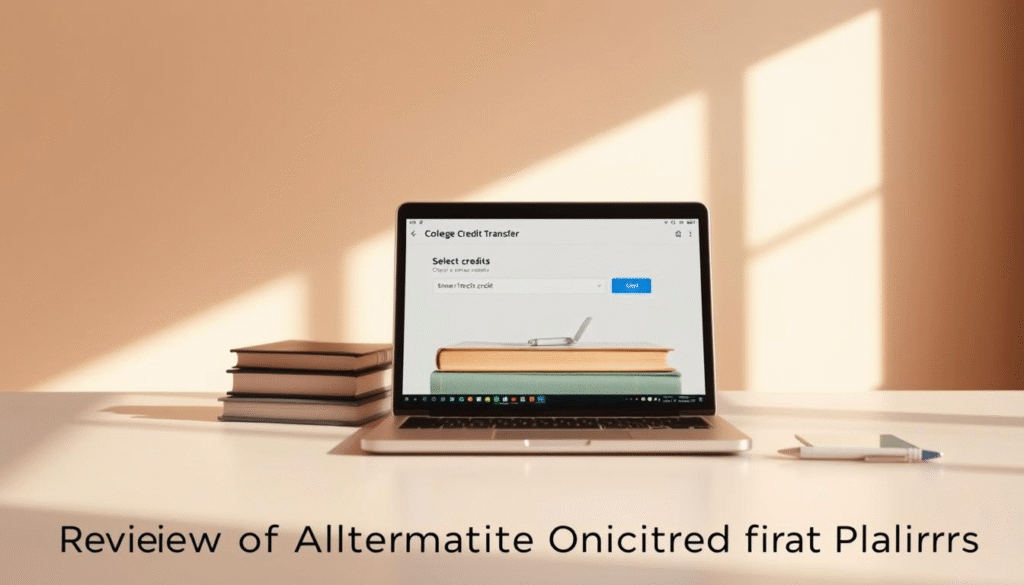Nearly 6 million students are taking online courses. This makes online learning a big part of higher education. The question of moving credits between schools is now more important than ever.

It’s key for students to know how to move online college credits from one place to another. The rules for moving credits vary a lot between colleges and universities. So, students need to understand these rules well.
Key Takeaways
- Transfer credit policies differ among institutions.
- Accreditation status affects transfer credit eligibility.
- Course equivalency is a key factor in transfer decisions.
- Students should consult with advisors to ensure smooth transfers.
- Transfer agreements between institutions can facilitate credit transfers.
The Landscape of Online College Education
The world of online college education has changed a lot in recent years. With new technology and changing educational needs, more students are choosing online learning. It’s now a popular option for students all over the world.
What Are Online College Credits?
Online college credits measure the completion of online courses or programs. These credits can often be used at traditional universities. Understanding online credits is key for students wanting to move to a traditional university.
Types of Online Education Providers
There are many types of online education providers. These include:
- Community colleges with online courses
- Universities with online programs
- MOOC (Massive Open Online Course) platforms like Coursera and edX
- For-profit online institutions
Growth and Evolution of Online Education
Online education has grown a lot. Many schools now offer online courses and degree programs. Online colleges often accept transfer credits more easily, helping students to keep learning.
The flexibility and reach of online education have led to its fast growth and change.
Can I Transfer Online College Credits to a University?
Students often wonder if they can move online college credits to a university. With online learning growing, knowing how to transfer credits is key.
General Transferability Overview
Whether you can transfer credits depends on a few things. These include the school’s accreditation and the university’s policies. Many schools have agreements to make transferring easier.
Accreditation is very important. It helps decide if credits will be accepted elsewhere. Credits from accredited schools are more likely to transfer.
Factors Affecting Credit Transfer Success
Several things can affect if credits transfer:
- The accreditation status of the school where credits were earned
- How similar the course content is to what the new school offers
- The grade you got in the online course
- The specific rules of the new school about accepting transfer credits
Statistical Success Rates of Online Credit Transfers
Many students have successfully moved online credits to traditional schools. About 70% of schools take online credits, showing a positive shift in online learning acceptance.
This success rate shows that online education is being seen as a real and valuable option for students.
Accreditation: The Foundation of Transferable Credits
Accreditation is key to making sure online college credits can move to a physical university. It checks if an institution meets quality and standards.
Regional vs. National Accreditation
There are two main types of accreditation: regional and national. Regional accreditation is seen as more prestigious. It goes to non-profit, degree-granting schools. National accreditation is often for for-profit schools or those with vocational programs.
Regional accreditation is better for transferring credits because it shows the school meets high academic standards. National accreditation is important but might not transfer as well, mainly to regionally accredited schools.
Programmatic Accreditation Importance
Some fields like engineering, nursing, and education need programmatic accreditation. This ensures the program meets the profession’s standards.
How to Verify an Institution’s Accreditation Status
To check if a school is accredited, look on their website or use the Database of Accredited Postsecondary Institutions and Programs by the U.S. Department of Education.
| Accreditation Type | Description | Transferability |
| Regional Accreditation | Awarded to non-profit institutions meeting academic standards | High |
| National Accreditation | Often associated with for-profit or vocational institutions | Variable |
| Programmatic Accreditation | Specific to certain professional programs | Essential for professional programs |
Review of Coursera for Credit Programs
Coursera is a top choice for online learning, with courses that might transfer to traditional universities. It works with over 200 leading universities worldwide. This offers a broad range of academic options.
Platform Overview
Coursera teams up with top universities and organizations to provide courses and degree programs. Its vast library covers subjects from humanities to STEM fields.
Coursera offers a wide range of courses, from single classes to full degree programs. Some of the top universities working with Coursera include:
- Stanford University
- University of Michigan
- University of Pennsylvania
- University of London
Pricing Structure
Coursera’s prices change based on the course or program. Some are free, while others cost money for certificates or credits. The price for credit-eligible courses usually falls between $30 and $90 per course.
Pros of Coursera Credit Courses
The advantages of Coursera’s credit courses are:
- Flexibility: Courses are online and can be done at your own pace.
- Accessibility: You can take courses from anywhere in the world.
- University-backed: Courses are taught by faculty from top universities.
Cons of Coursera Credit Courses
Some downsides to consider are:
- Transferability issues: Not all credits earned on Coursera are guaranteed to transfer.
- Limited program options: While Coursera has many courses, not all are for credit.
Transferability Features and Success Rate
How well Coursera credits transfer depends on the receiving university’s policies. Students should check with their university’s admissions or registrar’s office to see if credits will transfer.
Recommendations for Future Students
For those thinking about using Coursera for credit:
- Look into the credit transfer policies of universities you might attend.
- Pick courses that fit your degree needs.
- Talk to academic advisors to get the best advice.
Review of edX Credit-Eligible Courses
edX is known for its top-notch online courses that can earn you transfer credits. It’s a leader in Massive Open Online Courses (MOOCs). edX works with top universities around the world to offer a wide range of courses that can earn you credits.
Platform Overview
edX’s online platform offers flexible and affordable education. It has a variety of courses, from MicroBachelors to MicroMasters programs. These options meet different educational needs.
MicroBachelors and MicroMasters Programs
edX’s MicroBachelors programs teach career-relevant skills in a short time, usually a year or less. MicroMasters programs offer deeper knowledge in specific fields. Both are made by top universities and can count towards full degrees.
University Affiliations
edX works with famous schools like Harvard, MIT, and UC Berkeley. This means its courses are of the highest quality. These partnerships also make edX credits more credible and transferable.
Pros of edX Credit Courses
- Flexible learning options to fit any schedule
- High-quality content from top universities
- Variety of courses and programs available
- Potential for credit transfer to participating universities
Cons of edX Credit Courses
While edX has many benefits, there are some downsides. The cost of these courses can change, and not all schools accept edX credits. Some programs might also need extra fees for exams.
Transferability Features and Success Rate
edX has a credit transfer tool on its site. It helps students see which schools accept its credits. The success rate of transferring credits varies. But, many schools do accept edX courses. It’s key to check the transfer policies of your target schools.
Recommendations for Future Students
Before joining edX courses, check the credit transfer policies of your desired schools. Talking to academic advisors can also help. They can make sure the credits will be accepted.
Review of Alternative Online Credit Platforms
There are more than just MOOC providers for online credits. Other platforms are also popular. They offer courses that can be used at many schools.
Sophia Learning
Overview and Features
Sophia Learning is a place to learn online. It works with colleges and universities. It lets you earn credits that can be used elsewhere.

Sophia Learning is easy to use and affordable. But, it has fewer courses than big MOOC sites.
Transferability Success
Sophia Learning has many school partners. This makes it easy to move credits. Students have moved credits to over 300 colleges and universities.
StraighterLine
Overview and Features
StraighterLine offers online courses at good prices. It works with over 150 accredited schools.
Pros and Cons
It’s cheap and has many subjects. But, some might find the courses too strict.
Transferability Success
StraighterLine has a great track record for moving credits. This is thanks to its many school partners.
| Platform | Transferable Credits | Partner Institutions |
| Sophia Learning | Yes | 300+ |
| StraighterLine | Yes | 150+ |
In summary, Sophia Learning and StraighterLine are good choices. They help students get online credits that can be used at their schools.
The Credit Transfer Process Explained
Transferring online college credits to a university needs careful planning. It’s important to know the steps for a smooth transition. This ensures students get the most out of their credit transfer.
Pre-Enrollment Research Steps
Before starting an online course, research the university’s transfer policies. Find out what types of credits they accept, like general education credits or major-specific credits. Also, check if the online school is accredited by a recognized agency.
Documentation Requirements
Universities usually need official transcripts from the online school. They might also ask for course descriptions or syllabi. This helps them check the quality and content of the online courses.
Timeline Expectations
The credit transfer process can take weeks to months. Starting early is key to avoid delays in your studies.
Working with Transfer Advisors
Transfer advisors offer great help during the credit transfer process. They guide students through the requirements and make sure all documents are submitted right.
By following these steps and getting help from advisors, students can easily move their online credits to a physical university. This makes their education journey more efficient and stress-free.
Common Transfer Limitations and Restrictions
When you move online college credits to a traditional university, you face some limits. It’s key to know these to make the transfer smooth.
Credit Age Limitations
One big rule is the age of the credits. Many schools won’t accept credits that are too old.
Subject Matter Restrictions
Universities also check if the credits fit their courses. Some courses might not match what they offer.

Residency Requirements
Some schools require you to take a certain number of credits there. This is to make sure you’re part of the community.
Grade Requirements for Transfer
Universities set a minimum grade for transfer credits. Credits with lower grades might not be accepted or have limits.
| Limitation Type | Description | Impact on Transfer |
| Credit Age | Time limit on credit transfer | Older credits may not be transferable |
| Subject Matter | Relevance of course content | Non-relevant courses may not transfer |
| Residency | Requirement to complete credits within the institution | Limits the number of transferable credits |
| Grade | Minimum grade required for transfer | Low grades may not be transferable |
Strategies to Maximize Credit Transfer Success
Students looking to transfer online college credits to a university need to be proactive. They must use several key strategies to increase their chances of successful credit transfer.
Creating a Transfer Credit Plan
Creating a detailed transfer credit plan is the first step. This plan should list the courses to take, the institutions involved, and the expected outcomes. A clear plan helps students navigate the complex credit transfer process.
Articulation Agreements and Their Benefits
Articulation agreements between institutions make credit transfer easier. These agreements set a formal understanding on credit acceptance. Students should research and use these agreements to their advantage.
| Institution Type | Articulation Agreement Benefits | Transfer Ease |
| Community Colleges | Streamlined credit transfer to four-year universities | High |
| Online Education Providers | Recognition of online credits by partner institutions | Medium to High |
| Traditional Universities | Clear guidelines on credit transfer from other institutions | Medium |
Prior Learning Assessment Options
Prior Learning Assessment (PLA) lets students earn credits for knowledge gained outside the classroom. This includes work experience, professional certifications, and experiential learning. Using PLA options can help students finish their degree faster.
Appealing Denied Transfer Credits
If credits are denied, students can appeal the decision. They need to provide more information or context that supports the credits’ transferability. A successful appeal can lead to the acceptance of denied credits.
Case Studies: Successful Online to University Transfers
Online education has opened doors for students to move credits to traditional universities. Many stories show how this works. These stories prove that modern education is flexible and accessible.
Community College Online Credits to Four-Year University
Community colleges offer online courses that can lead to four-year universities. A student with online credits from a community college can usually get them counted towards a bachelor’s degree at a state university.
MOOC Certificates to Traditional Degree Programs
MOOCs, or Massive Open Online Courses, are a hit for earning credits. Some traditional universities now accept MOOC certificates as credits. They see the value in these online courses.
For-Profit Online College to Nonprofit University Pathways
Students from for-profit online colleges can move to nonprofit universities. This lets them keep learning in a more traditional setting. It’s a mix of online ease and the respect of a nonprofit school.

| Transfer Pathway | Typical Credits Transferred | Success Rate |
| Community College to Four-Year University | 30-60 credits | 85% |
| MOOC Certificates to Traditional Programs | 1-3 credits | 70% |
| For-Profit to Nonprofit University | 60-90 credits | 80% |
Conclusion
Transferring online college credits to a university depends on several factors. Accreditation is key in this process. Students need to check if their online courses are from accredited schools to have a better chance of transferring credits.
It’s important to know the specific rules of the university you want to transfer to. This includes rules on how old the credits can be, what subjects are allowed, and the grades needed. By planning ahead and using articulation agreements, students can increase their chances of a smooth transfer.
Being well-informed and proactive helps students overcome the challenges of credit transfer. This way, they can fully benefit from their online education.
Sources
For more details on moving online college credits, check out these resources:
- Coursera – Explore Coursera’s credit-eligible courses and programs.
- edX – Learn about edX’s credit-eligible courses and transfer policies.
- Accredited Schools Online – Understand the process of transferring online credits.
These sources are full of info on online learning and credit transfer. They help students make smart choices about their education.
FAQ
Can I transfer online college credits to a traditional university?
Yes, many traditional universities accept online college credits. But, it depends on the institution’s accreditation, the type of credits, and the university’s policies.
What is the difference between regional and national accreditation?
Regional accreditation is seen as more prestigious. It’s needed for transferring credits between schools. National accreditation is for vocational or technical schools. Credits from these schools might not transfer as easily.
How do I verify an institution’s accreditation status?
Check the institution’s website or contact the accrediting agency. You can also use online databases like the Council for Higher Education Accreditation (CHEA) or the US Department of Education’s Database.
Can I transfer credits from Coursera or edX to a university?
Coursera and edX offer courses that might be credit-eligible. But, transferring credits depends on the course, the institution’s policies, and your eligibility. Always check with the university first.
What are articulation agreements, and how do they benefit students?
Articulation agreements are deals between schools about transferring credits. They make transferring easier, reduce lost credits, and help students finish their degree faster.
Can I transfer credits from a for-profit online college to a nonprofit university?
Yes, transferring credits from a for-profit online college to a nonprofit university is possible. It depends on the accreditation, the type of credits, and the university’s policies.
What are the common limitations and restrictions on transferring credits?
Common issues include credit age limits, subject restrictions, residency rules, and grade requirements. Always check with the university for their specific policies.
How can I maximize my chances of successfully transferring credits?
To increase your chances, make a transfer plan, research the institution’s policies, and get help from a transfer advisor. Look into prior learning assessments and articulation agreements too.
Are online credits from Sophia Learning or StraighterLine transferable?
Sophia Learning and StraighterLine offer transferable credits. But, it depends on the institution’s policies and your eligibility. Always check with the university before enrolling.
What is the credit transfer process, and how long does it take?
The process includes research, documentation, and working with a transfer advisor. The time varies by institution and complexity. It can take weeks to months.
